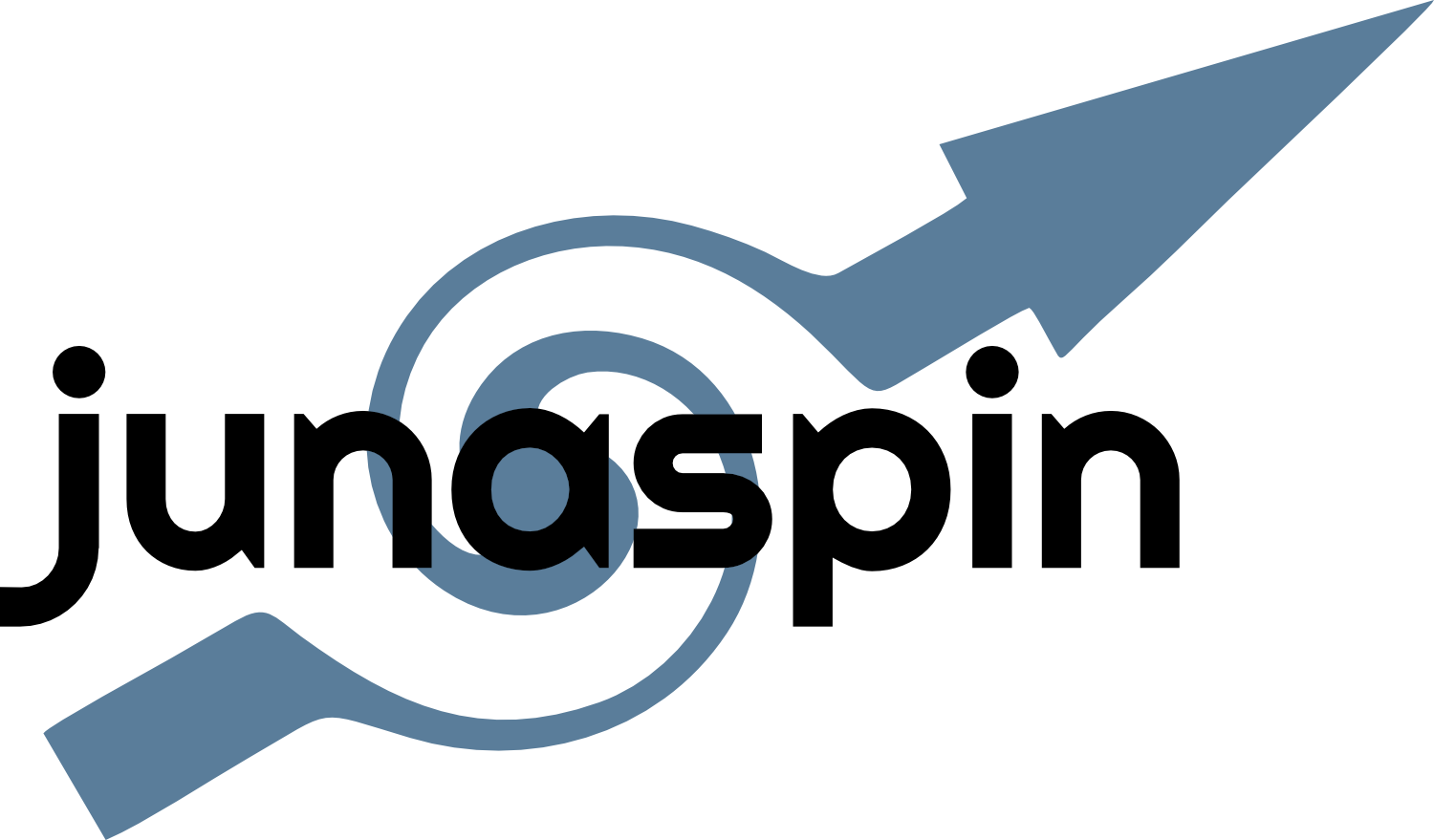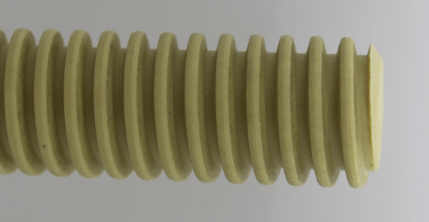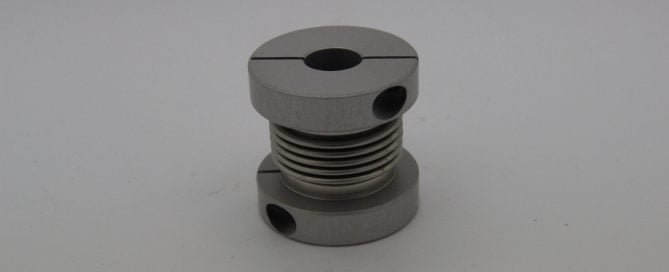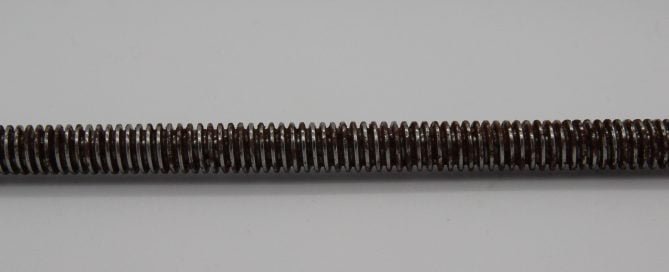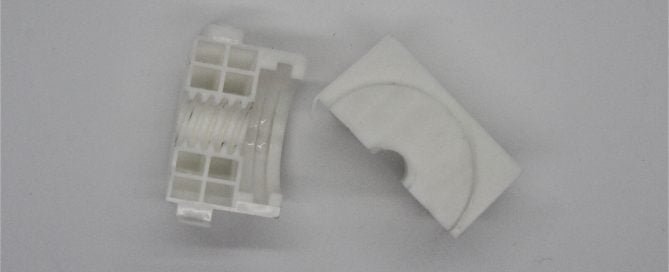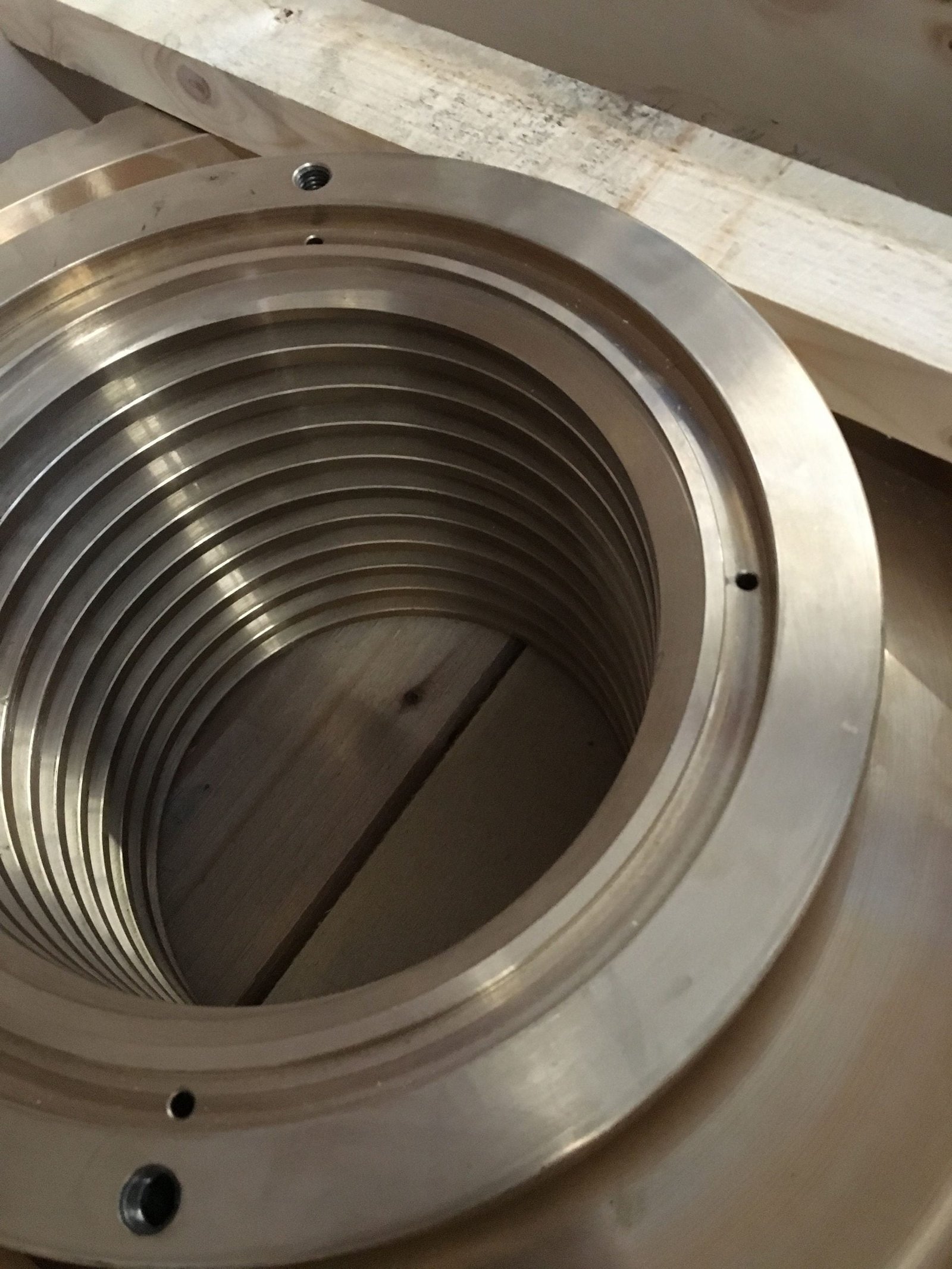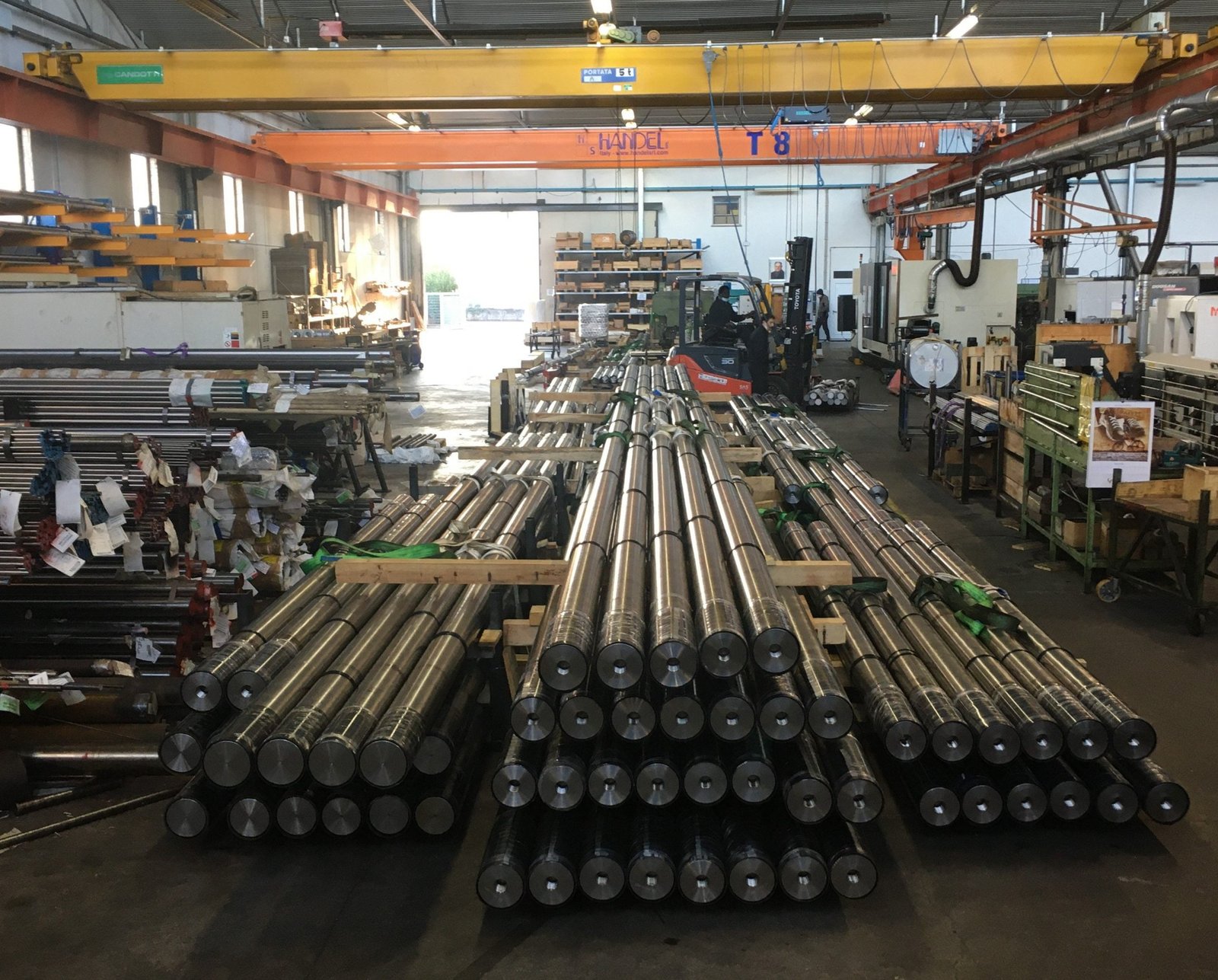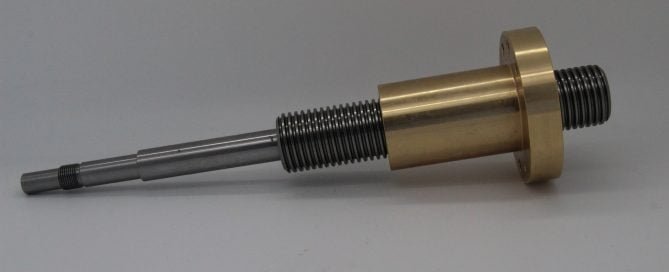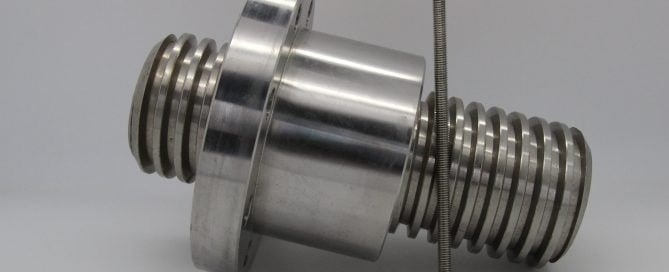- All
- applications in
- connection and operation
- designs
- Environmental conditions
- materials
- quality
- technical basics
- thread technology
Certain applications require non-magnetic screw drives. These applications are found primarily in the field of medical technology, for example in MRIs or other devices where metallic components are a hindrance to the process. Even in an already magnetic environment, a screw drive must be equipped as anti-magnetic as possible.
The choice of the threaded nut is the smaller problem in the implementation. Numerous standard and sliding plastics are available to the user. The use of special bronze alloys can also be a solution.
When choosing the spindle material, it becomes a little more difficult. Stainless steel is generally much less magnetic than free-cutting steel, but this is often not enough for use in certain applications. In principle, the respective alloy must be checked precisely with regard to its mechanical properties. From this it can then be deduced whether a material can be machined or cold-formed (rolled).
Titanium can often be used, and the threads can also be easily formed by rolling, but the machinability of this material is not very good. The manufacture of the spindle journals can therefore result in greater costs.
Plastic spindles are easy to cut, whirl or inject. The low strength of plastics is often a problem, as is the lack of dimensional stability due to thermal and hygroscopic influences (heat and moisture swelling).
Excellent alloys in terms of antimagnetism and suitability for rolling and machining can be found in the non-ferrous sector. Ms58 is often used for X-ray machines and MR tables.
Depending on the alloy and application, aluminum can also be a solution with regard to the non-magnetic design of a screw drive.
junaspin will be happy to support you in the selection and design of your screw drive. We would be happy to discuss with you how we can achieve sufficient antimagnetism in your application. In addition to the technical requirements, economic aspects are of course also relevant here. We can incorporate relevant experience from “real applications” here.
There are many possible applications for screw drives in agricultural machinery, for example in:
- Balers
- Fertilizer spreader
- Forage harvester
- Sprayers
- Combine harvesters and robots
- Seed drills
- Tractors
The applications in this branch have in common that all components have to be designed for daily use under rough conditions. In addition to dirt, vibrations and shocks are also criteria for the selection of thread components.
junaspin will be happy to support you in the selection and design of your screw drive. We would be happy to discuss your application with you.
There are many possible uses for screw drives in agricultural machinery and equipment, for example in:
- Automatic feeding machines
- Grain handling
- Dosing systems
- Gate valves for silos
- Barn ventilation systems
- Barn air conditioning
- Drives for stable doors
- Milking robot
- Robotic systems for harvesting, planting, dusting, weeding, etc.
- Agricultural drones
- Drives in greenhouses
- Drives for stable doors
The applications in this branch have in common that all components have to be designed for daily use under rough conditions. Many applications are outdoors, thread components must be dirt-resistant,
junaspin will be happy to support you in the selection and design of your screw drive. We would be happy to discuss your application with you.
There are many possible uses for screw drives in armaments and defense technology, however:
junaspin does NOT supply any systems to this branch.
We believe that guns can never solve conflicts in this world, even if they are only used for deterrence.
We expressly distance ourselves from the arms and arms industry.
junaspin is committed to the peaceful resolution of conflicts and the dialogue between peoples.
There are countless possibilities to use screw drives in automation, for example in:
- Automation systems and handling
- Inspection and testing systems
- Factory automation
- Assembly machines
- Robots
- Safety devices
- Measuring systems
- Light barrier and sensor adjustments
- Stacking devices
- Intralogistics
The specialty of these applications is that systems not only have to run reliably but usually also have immensely high mileage. Therefore, screw drives must be designed to be virtually wear-free.
junaspin will be happy to support you in the selection and design of your screw drive. We would be happy to discuss your application with you.
There are countless possible applications for screw drives in aviation, for example:
- Seat adjustments
- Landing gear drives
- Elevation and azimuth drives in satellite systems
- Landing flap drives
- Door drives
- Adjustments of the interior such as screens, leg rests, armrests, etc.
The specialty of this branch is that absolutely reliable systems are required that withstand the strict test programs with sometimes high levels of abuse. At the same time, it is imperative that the components be optimized in terms of weight. The technologies of thread rolling and injection molding have proven themselves here.
junaspin will be happy to support you in the selection and design of your screw drive. We would be happy to discuss your application with you.
There are many possible uses for threaded rods in bridge and clamping technology, for example:
- Bracing systems for ropes
- Transverse prestressing of deck slabs
- Individual tendons with prestressing bars
- Rope holder and rope hanger
- Ring rope connector
- Compression rod systems
- Conical potting sleeves, potting sleeves with eye stick
The applications in this branch have in common that only high-quality rust-resistant steels may be used and the calculations must be checked by structural engineers. Very large diameters and lengths are often used.
We have appropriate manufacturing concepts ready for applications of excess lengths and special dimensions.
junaspin will be happy to support you in the selection and design of your screw drive. We would be happy to discuss your application with you.
There are countless possible applications for screw drives in building technology, for example:
- Shading
- Tracking systems for photovoltaics
- RWA drives
- Door drives
- Person locks
- Stairlifts
- Locking systems
The specialty of this industry is that systems have to run reliably and have to be optimized in terms of efficiency in order to meet the ever increasing demands on energy efficiency. At the same time, due to the high number of units, the components also have to be optimized with regard to the production method. The technologies of thread rolling and injection molding have proven themselves here.
For many products there are additional requirements with regard to safety (e.g. safety nuts) and fire protection tests.
junaspin will be happy to support you in the selection and design of your screw drive. We would be happy to discuss your application with you.
There are countless possible applications for screw drives in caravans and mobile homes, for example:
- Caravan supports
- Electrically adjustable bike racks
- Bed drives
- Window and door drives
- In drawbar wheel units
- Lifting roof drives
- Steps
The specialty of this branch is that systems not only have to run noise-free and reliably, but also very often have to compensate for rough tolerances. Screw drives must be protected against corrosion and require little maintenance. Due to the vibrations when driving, more attention must also be paid to the subject of vibration damping.
junaspin will be happy to support you in the selection and design of your screw drive. We would be happy to discuss your application with you.
There are many possible uses for screw drives in CNC machines, for example:
- Traversing the X / Y / Z axes
- Hold-down
- Tool changer
- Lead screws
- Work spindles
- Door drives
- Material handling
These applications can be found in lathes, milling machines, presses, grinding machines, straightening machines, surface processing machines, planing machines, eroding machines, drilling machines, sheet metal processing machines, 3D printers, saws and other related machines.
The applications in this branch have in common that high-precision solutions are sought. Most of the applications are realized with ball screws, but trapezoidal threads are also used. Pre-tensioned threaded nuts or lock nuts are often used here.
In addition to precision, protection against chips is also a very important issue in machining applications. Here we offer systems with wipers or bellows.
junaspin will be happy to support you in the selection and design of your screw drive. We would be happy to discuss your application with you.
Sliding screw drives are less susceptible to dirt than ball screws. However, depending on the type of contamination and the frequency of adjustment, the contamination must be dealt with differently.
In the case of very fine dirt, such as cement dust, flour, textile fibers, etc., the use of dry-running systems has proven itself. By dispensing with lubricants, the sticking of soft particles and fibers on the spindle is avoided.
In the case of coarse dirt, such as metal shavings, wood shavings, earth and other coarse solids, the use of a scraper or a scraper brush can be useful. See also Wiper for trapezoidal screw drives .
If the dirt is very abrasive, such as diamond, granite or corundum particles, the screw drive should be covered. Bellows are ideal for this.
In some applications, a dirt-resistant drive could also be achieved by making appropriate lubrication grooves. Corresponding relubrication intervals were specified by the user. Regular lubrication “pushes” the dirt out of the nut. The dirt is “embedded” in the lubricant and therefore has a smaller negative impact on the service life.
In all cases it should of course be noted that the dirt has an influence on the service life.
junaspin will be happy to help you choose a wiper or bellows. We can also judge on the basis of our experience whether the use of a dry-running system is possible in your application.
There are many ways to use screw drives in fittings and valve technology, for example in:
- Electromechanical actuators
- Control valves
- Control valves
- Stem gate valve
- Rotary actuators
- Linear drives
- Stuffing box shut-off valves
The specialty of these applications is that the materials usually have to be resistant to chemicals and acids. In addition, the screw drives are often heavily loaded. In many cases, valve spindles are thicker than the drive thread in some places. Therefore, the production methods of thread whirling and thread cutting are ideal here. The spindles can then be hot-formed, manufactured “from solid” or assembled from two parts.
junaspin will be happy to support you in the selection and design of your screw drive. We would be happy to discuss your application with you.
In general mechanical engineering there are countless possibilities to use screw drives, for example in:
- Clamping devices
- Format adjustments
- Sliders
- Drives
- Latches
- Dosing systems
- Lifting systems
- Turning devices
- Measuring systems
- Hold-downs
- Clamping units
- Linear units
The requirements for the components are as different as the industries in which the products can be used. Applications can be found in almost all industries, such as wood processing, food processing, intralogistics, textile industry, cement and stone processing, packaging technology, valve construction, construction machinery, drive technology, plastics processing, recycling, dosing systems, automation technology, handling systems, machine tools, device construction and many other industries .
junaspin will be happy to support you in the selection and design of your screw drive. We would be happy to discuss your application with you.
There are many possible applications for screw drives in power plant technology, for example:
- Drives for locks, weirs and gates
- Valve actuators
- Actuating cylinder drives
- Drives for UV water treatment
The applications in this branch have in common that only high-quality rust-resistant steels may be used and the calculations must be checked by structural engineers. Very large diameters and lengths are often used.
We have appropriate manufacturing concepts ready for applications of excess lengths and special dimensions.
junaspin will be happy to support you in the selection and design of your screw drive. We would be happy to discuss your application with you.
There are countless possible applications for screw drives in reciprocating devices, for example:
- Pallet lifting device
- KLT lifter
- Stacking device
- Lift tables
- Lifting jacks
- Stage height adjustments
- Lifting platforms
- Coil and foil lifter
- Stairlifts
- Elevator systems
- Tumbler
The specialty of these applications is that the systems are usually very heavily loaded and often also have to absorb radial forces. Lifting devices are used in a wide variety of industries, so the screw drives must be able to adapt to the most varied of environmental conditions.
junaspin will be happy to support you in the selection and design of your screw drive. We would be happy to discuss your application with you.
There are innumerable possible applications for screw drives in medical technology, for example:
- Imaging diagnostics (MRT / CT / X-ray)
- Dental ovens
- CAD / CAM systems
- Scanner systems
- Ointment mixing systems
- Pharmacist storage and retrieval machines
- Drives for agitators
- Operating tables, treatment tables and hospital beds
- Cleaning technology
- Laboratory equipment
- Dosing devices
The applications in this branch are very different. Very high levels of accuracy are required in laboratory devices and CAD / CAM systems, while non-magnetic components are usually required in the drives of CTs, MRIs and X-ray systems. While handling, scanners and laboratory devices require very high mileages over their service life, applications in ointment mixing systems, dosing devices and dental ovens are relatively static.
All applications have in common that the screw drives have to function reliably, quietly and as free of lubricants as possible, even under the corresponding stress loads.
junaspin will be happy to support you in the selection and design of your screw drive. We would be happy to discuss your application with you.
There are countless possible applications for screw drives in office machines, for example:
- Format adjustment in printer
- Destacking in printers
- Drives for scanners
- Drives of optics
- Labeling machines
- Franking machines
- ATMs
- Data storage systems
Similar applications can be found in similar areas such as mail sorting, camera technology, vending machines and lighting technology.
The specialty of these applications is that systems not only have to run reliably but also often have to deal with paper fibers or paper dust and other contaminants. Therefore, screw drives should usually be designed to be maintenance-free. At the same time, due to the high number of units, the components also have to be optimized with regard to the production method. The technologies of thread rolling and injection molding have proven themselves here.
junaspin will be happy to support you in the selection and design of your screw drive. We would be happy to discuss your application with you.
There are countless possible applications for screw drives in rehabilitation and sports equipment, for example:
- Format adjustments
- Seat adjustments
- Weight adjustments
- Display adjustments
- Vehicle conversions suitable for the disabled
The specialty of this branch is that systems not only have to run noise-free and reliably, but also often have to be protected against corrosion and low-maintenance. At the same time, due to the high number of units, the components also have to be optimized with regard to the production method. The thread rolling technology has proven itself here.
junaspin will be happy to support you in the selection and design of your screw drive. We would be happy to discuss your application with you.
There are many possible uses for screw drives in solar technology, for example:
- Tracking systems for PV, CPV and CSP
- Single and multi-axis systems
- Light control systems
The applications in this branch have in common that all components have to be UV, ozone and rust resistant. Solutions for strong temperature fluctuations and intensive pollution must also be worked out. Often there are additional requirements for fire protection
junaspin will be happy to support you in the selection and design of your screw drive. We would be happy to discuss your application with you.
The use of screw drives in the field of applications in the packaging industry is very common. In almost all areas of the packaging / food and pharmaceutical industry, there are applications for screw drives, for example in form / fill / seal machines, tray sealing machines, dosing systems, cartoning machines, tubular bag machines, strapping machines, weighing systems, blister packs, filling machines, inspection systems, conveyor technology, cleaning technology, Blow molding machines and labeling.
Classic applications are format and lane adjustments, adjustments of sensors and cameras, lifting units, conveyor lines, hold-down devices, height adjustments and valve drives.
The specialty of this branch is that absolutely reliable systems are required which can cope with the ambient conditions and the high cycle rates. Mostly the requirement is that screw drives work absolutely maintenance-free and without separate lubrication. In addition to FDA and NSF approval, there are requirements for media resistance, detectability, Temperature resistance , Dirt resistance , Corrosion resistance and the possibility of cleaning (also during operation).
Many of the above-mentioned requirements can be achieved by combining sliding thread spindles made of stainless steel with a plastic nut; slide-coated spindles are also used again and again in these applications.
Ball screw drives made of stainless steel are also part of the delivery program of junaspin GmbH. the Junagrease lubricant has FDA approval and has already been successfully used in wash-down applications.
junaspin is happy to support you in the selection and design of your screw drive in relation to the tasks typical of the industry.
Countless screw drives are installed in a modern vehicle, e.g. in the following applications:
- Seat adjustments
- Adjustment systems for steering wheels, armrests, neck rests, etc.
- Cornering lights
- Systems for doors and tailgates
- Drives for sliding doors
- Locking systems
- Spoiler drives
Similar applications can be found in “car-like” applications such as tractors, municipal vehicles, floor conveyors, automated guided vehicles (AGVs), buses and trains, racing, mobile homes and caravans.
The specialty of this branch is that absolutely reliable systems are required that withstand the strict test programs with sometimes high levels of abuse. At the same time, due to the high number of units, the components also have to be optimized with regard to the production method. The technologies of thread rolling and injection molding have proven themselves here.
junaspin will be happy to support you in the selection and design of your screw drive. We would be happy to discuss your application with you.
In the furniture industry there are countless possible uses for screw drives, for
Example:
- Height adjustment of tables
- Height adjustment of chairs
- Bed drives
- Door drives
- in locking systems for safes and other furniture
- retractable design elements
The specialty of this branch is that systems are not only noise-free and reliable
have to run, but also often have to meet design requirements. Must have at the same time
the components due to the high number of pieces also with regard to the production method
be optimized. Here, the technologies of thread rolling and
Injection molding has proven its worth.
junaspin will be happy to support you in the selection and design of your screw drive. With pleasure
we will discuss your application with you.
There are countless possible applications for screw drives in semiconductor manufacturing, for example in:
- Wafer manufacturing
- Semiconductor assembly
- Semiconductor packaging
- Chillers
- Vacuum systems
- Wafer handling
- Thermal management
Similar applications can be found in the electronics industry, for example in limit switches for sensors, high-voltage switching technology and in drives for pantographs.
The specialty of these applications is that systems not only have to run reliably but also have to meet requirements for electrical properties (current insulation or current-conducting). Fire protection requirements are also often made.
junaspin will be happy to support you in the selection and design of your screw drive. We would be happy to discuss your application with you.
There are countless possible applications for screw drives in traffic engineering,
for example:
- Drives for bus and train doors
- Drives for sliding steps
- Seat adjustments in rail and aviation technology
- Point machines
- Lifting platforms for buses and trains
- Linear travel switches for ships and railways
- Drives for pantographs
- Locking systems
The specialty of this branch is that systems are not only reliable and maintenance-free
have to run, screw drives are often also optimized in terms of weight.
junaspin will be happy to support you in the selection and design of your screw drive. With pleasure
we will discuss your application with you.
In vending machines and coffee machines, screw drives are often used, for example:
- Brew group drive
- Cup table adjustments
- Drives for goods issue
- Height adjustments of the removal module
- Locking systems
The specialty of these applications is that systems not only have to run reliably but often also have direct contact with food. A screw drive therefore usually has to be designed to be maintenance-free. At the same time, due to the high number of units, the components also have to be optimized with regard to the production method. The technologies of thread rolling and injection molding have proven themselves here.
junaspin will be happy to support you in the selection and design of your screw drive. We would be happy to discuss your application with you.
The use of screw drives in applications in the medium or under water is possible. These are applications in test stands, laboratory equipment, in food and filling technology, in the offshore area, in valve technology and diving robots.
The specialty of these applications is that absolutely lubrication-free and reliable systems are required. In addition to the other application conditions, the issues of corrosion resistance and media resistance must also be considered separately. Atmospheric pressure must also be taken into account for deep-sea applications.
In many applications in low-viscosity media, an improvement in service life or a reduction in friction and wear could also be observed. The medium lies between the spindle and the nut and thus serves as “lubrication”. Depending on the speed and construction of the system, a hydrodynamic effect can even occur.
junaspin is happy to support you in the selection and design of your screw drive for use in the medium. The focus here is specifically on the selection of materials.
Threaded nuts must be secured against turning or axial displacement.
The torsion and axial locking is usually provided by the design, for example by fastening on the flange, axial or radial bores or by a form fit (for example a wrench surface). In the case of metallic threaded nuts and low torques, it is also conceivable to glue in threaded nuts; in the case of higher torques, nuts can also be welded.
With flange nuts made of plastic, the maximum tightening torque (2.5 Nm) of the fastening screws must be taken into account. Metallic press-fit sleeves are ideally used to achieve higher tightening torques. The use of liquid screw locking agents has also become established (for example Loctite 270 or Loctite 243).
In certain applications, the use of axially split threaded nuts may also be necessary or useful.
Before assembly, the nut should be lubricated if the material combination and the application require it.
When pulling the threaded nut onto the spindle, make sure that the spindle is cleanly deburred. A hand bevel makes assembly easier.
Ball screw nuts are usually supplied on an assembly sleeve. With KGT nuts, it is essential to ensure that the nut is not simply pulled from the spindle or assembly sleeve, as otherwise balls could fall out and the nut can no longer absorb the maximum forces.
junaspin is happy to help with the assembly and selection of your threaded nuts. Contact us.
Surface coatings have always been used to increase the durability of a threaded spindle. Coatings as corrosion protection, such as electro-galvanizing, hot-dip galvanizing, chrome-plating, phosphating, burnishing, bonding, thick-film passivation, nitro-carburizing, anodizing, anodizing and, in some cases, also painting, are established here as corrosion protection.
These coatings are mainly used for static threads, i.e. fastening threads. The usability of these coatings must be considered separately for dynamic applications, i.e. for drive, standard and movement threads. A deterioration in the coefficient of sliding friction can often be observed in combination with the surface coatings mentioned. The durability of the coating must also be checked on a case-by-case basis. The mechanical stress can cause the coating to wear off.
Bonded varnishes and coatings are used again and again for dynamic applications. This enables an absolutely dry run, which is absolutely necessary in laboratory equipment, in the food industry and in the pharmaceutical sector. There are no maintenance intervals and the coating does not attract any dirt particles, unlike lubricants. These sliding coatings are mostly based on PTFE.
There are also coatings and technologies available on the market to increase surface hardness, improve temperature resistance and improve resistance to acids, bases and solvents.
junaspin can have almost all coatings applied by external partners. Depending on the process, the layer thickness must be observed so that the desired components are still true to gauge even after coating.
junaspin is happy to help you choose a surface. In addition to the question of manufacturability, we also have experience with the application and durability of various coatings and surface processes. In addition to the pure calculation, experience from “real applications” and tests can also be incorporated.
The coefficient of sliding friction of a screw drive results from the sliding pairing between spindle and nut. Other factors are the axial load, the pitch of the spindle and possible external lubrication. In order to achieve a high level of efficiency and to reduce the drive torque, it is essential to optimize the coefficient of sliding friction.
In principle, coefficients of friction are divided between static and dynamic values. The static value indicates the coefficient of friction, i.e. the breakaway torque to set the nut in motion. The dynamic value relates to a screw drive that is already in motion.
While the thread profile is mostly specified by the application, a great improvement can be achieved through the use of suitable sliding pairs.
The combination of an aluminum spindle with a plastic nut has proven to be ideal for small loads. In the high-load range, enormous successes can be achieved with whirled or ground spindles in combination with modern high-performance bronzes and lubrication.
The use of the right lubricant is still an essential factor for high-speed or highly stressed screw drives. The “junagrease spindle grease” was specially developed for the lubrication of screw drives (especially ball screws, trapezoidal threads and high helix threads). But the use of maintenance-free, i.e. unlubricated materials is also becoming more and more popular.
Junaspin is happy to help with the design. Thousands of test results are documented in our database. In addition to the pure calculation, experience from “real applications” and tests can also be incorporated.
Comparison of friction coefficients
| Sliding pair | static | dynamic | ||
| Spindle / nut | dry | Junagrease lubrication | dry | Junagrease lubrication |
| Steel / steel | 0,30-0,35 | 0,09-0,15 | 0,15-0,20 | 0,05-0,10 |
| Steel / cast iron | 0,19-0,24 | 0,10-0,15 | 0,10-0,15 | 0,05-0,08 |
| Steel / gunmetal | 0,19-0,24 | 0,10-0,15 | 0,10-0,15 | 0,05-0,08 |
| Steel / aluminum bronze | 0,18-0,24 | 0,08-0,13 | 0,08-0,13 | 0,04-0,08 |
| Steel / PA6.6 | 0,20-0,25 | 0,04-0,06 | 0,10-0,14 | 0,02-0,04 |
| Steel / POM | 0,20-0,25 | 0,04-0,06 | 0,10-0,14 | 0,02-0,04 |
| Steel / plastic with optimized sliding properties * | 0,18-0,23 | 0,03-0,05 | 0,08-0,13 | 0,01-0,03 |
| Stainless steel / stainless steel | 0,30-0,35 | 0,09-0,15 | 0,15-0,20 | 0,05-0,10 |
| Steel / stainless steel | 0,30-0,35 | 0,09-0,15 | 0,15-0,20 | 0,05-0,10 |
| Stainless steel / gunmetal | 0,20-0,25 | 0,04-0,06 | 0,10-0,15 | 0,05-0,08 |
| Stainless steel / PA6.6 | 0,20-0,25 | 0,04-0,06 | 0,10-0,14 | 0,02-0,04 |
| Stainless steel / POM | 0,20-0,25 | 0,04-0,06 | 0,10-0,14 | 0,02-0,04 |
| Stainless steel / plastic with optimized sliding properties * | 0,18-0,23 | 0,03-0,05 | 0,08-0,13 | 0,01-0,03 |
| Hard anodized aluminum / POM | 0,16-0,20 | 0,02-0,06 | 0,05-0,08 | 0,01-0,03 |
| Hard anodized aluminum / plastic with optimized sliding properties * | 0,14-0,18 | 0,01-0,04 | 0,05-0,07 | 0,01-0,03 |
* Average value of various sliding plastics
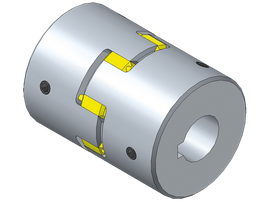
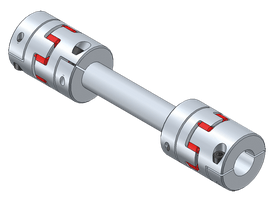
A shaft coupling is required to connect the threaded spindles to the motor shaft. The coupling must transmit the rotary movement and the torque of the motor to the spindle to be driven.
Depending on the offset to be compensated (axial, lateral or angular), rigid couplings, elastomer couplings (also known as claw couplings) or metal bellows couplings are available.
In order to synchronize two screw drives, it is possible to use intermediate shaft couplings.
The coupling is usually connected using a keyway connection. However, there are also variants with a clamping hub, with a conical clamping ring or with an expanding mandrel available on the market.
junaspin is happy to support you in the selection and design of your shaft coupling. We supply couplings from our partner StS Coupling GmbH from Niedernberg.
Of course, threaded rods made of steel can also rust from the influence of moisture and chemicals. But contact corrosion, vibration corrosion, surface corrosion and crevice corrosion cannot be ruled out with threaded spindles made of steel.
If there are problems with the formation of corrosion, initial lubrication is often sufficient to preserve the spindle. When choosing one Spindle fat Care should be taken to ensure that the grease is reversible and washable.
Should the lubrication not be sufficient too Coatings be a sensible alternative to stainless steels. Electro-galvanizing, hot-dip galvanizing, chrome-plating, phosphating, burnishing, bonding, thick-film passivation, nitro-carburizing, anodizing, anodizing and painting are particularly suitable for screw drives. The suitability of the coating in terms of wear resistance and coefficient of sliding friction must be checked separately.
If the use of surface coatings is not sufficient to achieve a suitable corrosion protection class, the only option is to use stainless steels (Inox, VA steel, Nirosta). However, not all stainless steels are equally suitable for thread rolling. In addition to the yield point, there are a few other parameters to consider.
Titanium, bronze and aluminum can also solve problems with regard to corrosion.
junaspin can have almost all coatings applied by external partners.
In addition to the question of manufacturability, we also have experience with the application and durability of various alloys and surface processes. In addition to the pure calculation, experience from “real applications” and tests can also be incorporated.
With threaded spindles, there is a risk of lateral buckling under axial compressive stress.
In order to avoid buckling, the maximum permissible axial force according to Euler (case I-IV) must be calculated. Of course, as with all calculations, appropriate safety factors must be taken into account.
junaspin is happy to support you in the selection and design of your screw drive. We are happy to calculate the critical buckling force of your screw drive for you. In addition to the calculation, we can also incorporate experience from “real applications” and tests.

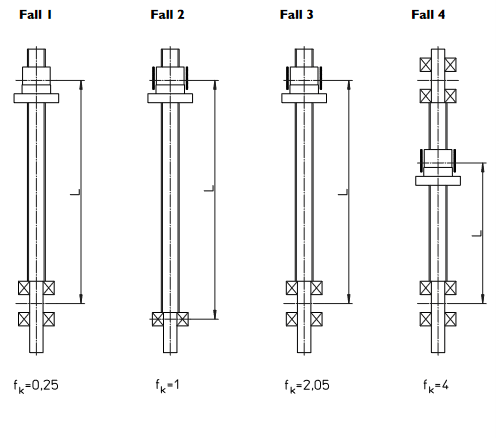
Since radial loads of a screw drive are usually absorbed by linear guides, only the dead weight of the unsupported spindle applies with regard to the deflection of a spindle.
In addition to the weight / meter of the spindle and the strength values of the material, the unsupported length is particularly relevant for calculating the deflection. There is also a correction factor that takes the spindle bearing into account (graphic case I-IV).
The deflection of the spindle that occurs during horizontal installation can increase in the application Noises and lead to increased wear.
This can be remedied by shortening the unsupported length, increasing the diameter or changing the mounting.
junaspin is happy to support you in the selection and design of your screw drive. We are happy to calculate the deflection in your application for you. In addition to the calculation, we can also incorporate experience from “real applications” and tests.
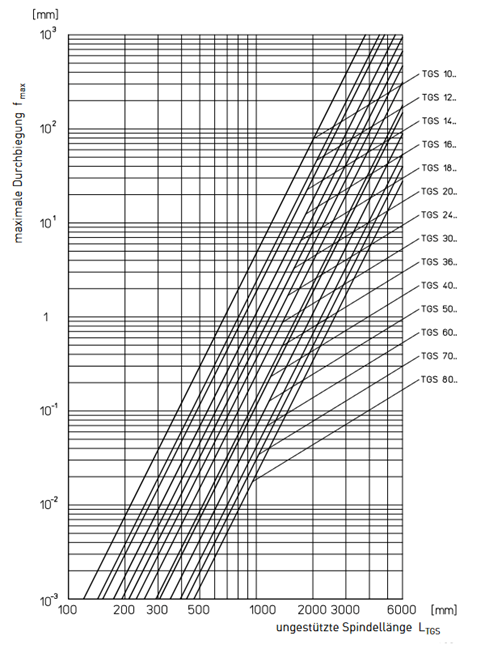
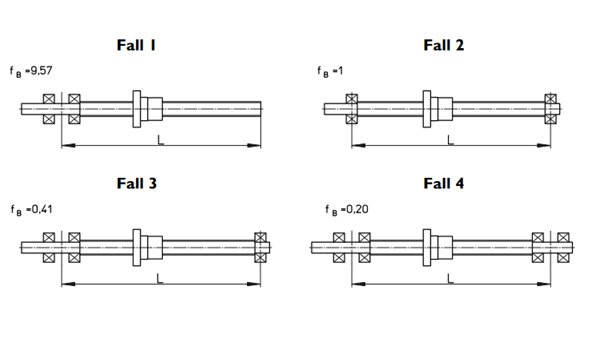
The use of unlubricated sliding screw drives is essential in many applications. This applies to applications in laboratory equipment, in the food industry, in the packaging industry and in the pharmaceutical sector. Such systems are also used in dirt-intensive applications such as the textile industry and in processing machines.
Dry running is ensured either by the nut material (e.g. special bronze, sliding plastic) or by the spindle material (e.g. Ms58) or by a Spindle coating achieved. Particularly good results in terms of Coefficient of friction and wear are achieved with slide-coated spindles in combination with slide-optimized plastics.
By dispensing with lubricants, there are no manufacturing costs, there are no maintenance costs when operating the screw drive, causes of errors (insufficient lubrication) are avoided and the life cycle assessment of a screw drive is significantly improved.
junaspin is happy to support you in the selection of materials that enable dry running. In addition to the question of manufacturability, we also have experience with the application and durability of various coatings and materials. In addition to the pure calculation, experience from “real applications” and tests can also be incorporated.
Sliding screw drives are generally not suitable for continuous operation. The heat generated by friction is the limiting factor for the duty cycle. This heat must be able to be dissipated from the system.
In order to be able to define the maximum permissible duty cycle of a screw drive, the p * v – value (pv value) decisive. Frictional heat arises mainly when high loads (p) are combined with high speed (v). If only one of the two values is very high, the duty cycle is less limited.
The use of a sliding pair with the lowest possible coefficient of friction naturally fundamentally reduces the pv value. Choosing the right one Lubricant significantly helps to minimize friction and increase the maximum permissible duty cycle.
In addition to the pv value, heat dissipation is also an issue. If the heat can be dissipated via the spindle or nut, longer duty cycles can be made possible. Plastic nuts are of course disadvantageous here, the use of an aluminum spindle would be advantageous.
The stroke length also has an influence. With very short strokes with a long duty cycle, more heat is generated than with a comparable application with a longer stroke, as the heat can get better out of the system via the spindle.
With regard to a high duty cycle, external cooling can also be an option. This can be done through the construction, for example through a cooling channel in the spindle or through the environment, for example through a fan.
In the case of short switch-on times, the maximum permissible pv value can be provided with a correction factor.
However, it is imperative to note:
In addition to the max. permissible duty cycle, the wear must be considered separately in each case.
junaspin is happy to support you in the selection and design of your screw drive. We are happy to increase the max. Calculate the permissible duty cycle of your screw drive for you, taking into account the service life. In addition to the calculation, we can also incorporate experience from “real applications” and tests.
The efficiency describes the relationship between the output and the input power. As a rule, the highest possible degree of efficiency, i.e. a low loss of power, is aimed for.
The efficiency is determined by the thread profile (thread type), the pitch (flank angle), the load and the coefficient of friction (i.e. the sliding pair).
In order to achieve the highest possible degree of efficiency, attention should be paid to the details when selecting the dimensions and thread profiles. By optimizing the sliding pairing and choosing the right lubricant, the efficiency of existing screw drives can also be increased.
The efficiency can usually be documented via the current consumption of the motor.
The efficiencies vary greatly. These are between 15% (single-start, unlubricated sliding thread) up to 99% (optimized ball screw drives)
Junaspin is happy to help with the design. Thousands of test results are documented in our database. In addition to the pure calculation, experience from “real applications” and tests can also be incorporated.
The heat generated by friction is the limiting factor for the usability and duty cycle of a screw drive. This heat must be able to be dissipated from the system.
In order to be able to define the usability of a screw drive, the p * v – value (pv value) decisive. Frictional heat arises mainly when high loads (p) are combined with high speed (v). If only one of the two values is very high, the use is less limited.
The use of a sliding pair with the lowest possible coefficient of friction naturally fundamentally reduces the pv value. Choosing the right one Lubricant significantly helps to minimize friction and improve the area of application.
In addition to the pv value, heat dissipation is also an issue. If the heat can be dissipated via the spindle or nut, longer duty cycles can be made possible. Plastic nuts are of course disadvantageous here, the use of an aluminum spindle would be advantageous.
The stroke length also has an influence. With very short strokes with a long duty cycle, more heat is generated than with a comparable application with a longer stroke, as the heat can get better out of the system via the spindle.
With regard to high frictional heat, external cooling can also be an option. This can be done through the construction, for example through a cooling channel in the spindle or through the environment, for example through a fan.
In the case of short switch-on times, the maximum permissible pv value can be provided with a correction factor.
However, it is imperative to note:
In addition to the general applicability, the wear must be considered separately in each case.
junaspin is happy to support you in the selection and design of your screw drive. We are happy to increase the max. Calculate the permissible duty cycle of your screw drive for you, taking into account the service life. In addition to the calculation, we can also incorporate experience from “real applications” and tests.
The use of screw drives in the field of high-energy radiation is made possible by the use of special materials.
Depending on which radiation is present (electromagnetic radiation, radioactive radiation, electron radiation, neutron radiation, ion radiation) and how high the dose and the duration of the radiation exposure is, different materials can be used.
In the case of metallic materials, Cr-Ni steels with 15-17% Cr and 13-16% Ni are mainly used, and aluminum alloys are also used occasionally.
For thermoplastic materials, PVDF, PI, PEI, PSU and PEEK in particular have proven their worth. With these materials, radiation resistances of up to 1×10 5 Gy reached.
If the radiation intensity is low, the inexpensive material ABS can also be used.
junaspin is happy to support you in the selection and design of your screw drive, also with regard to high-energy radiation.
Thread nuts are mostly manufactured mechanically due to the required quantities and accuracies. When using plastics, however, the manufacture of injection molding processes is also an option.
Threaded nuts can be completely injected. A thread with small pitches is removed from the mold with a driven tool core (for example with single-start trapezoidal threads, round threads, metric threads, etc.) or with very high pitches also with a slide (e.g. with multi-start trapezoidal threads or high-helix threads without self-locking).
Alternatively, partial production using the injection molding process is also worthwhile. For example, the “nut body” can be injected and the thread is produced mechanically, or “nut blanks” can be produced and the component only partially machined.
Often, threaded nuts are also manufactured in two parts using the injection molding process. Individual “nut halves” are not only very easy to demold, they also make assembly much easier
Through the use of rapid tooling concepts, i.e. the production of tools made of aluminum, small series from around 100 pieces can also be economical in the injection molding process.
Injection molded nuts should not be constructed with thick walls. In addition to sink marks, there is a risk that air inclusions (blowholes) could weaken the component. This problem can be countered with franking. The required strengths can then be achieved by bracing.
In the development of injection-molded nuts, it has proven useful to use materials that are available both as semi-finished products and as granules. A series application can be checked with machined parts.
junaspin will be happy to support you in the selection of materials and the design of your threaded nut. We have extensive knowledge of toolmaking and materials science. In addition to the technical requirements, economic aspects are of course also relevant here. Thousands of test results are documented in our database. In addition to the pure calculation, experience from “real applications” and tests can also be incorporated.
The importance of good lubrication is more well known today than ever. Experts estimate the annual follow-up costs due to insufficient lubrication in German mechanical engineering at high three-digit million sums.
Lubricants help to reduce friction and wear. A positive side effect of the lubricating properties is that the drive requires less energy and the efficiency is significantly improved.
When selecting a lubricant, the required temperature range must be taken into account. The material compatibility must also be taken into account. Not every lubricant is compatible with plastics and therefore also suitable for sliding screw nuts made of plastics (such as POM, PEEK, PA6.6 and other sliding-modified plastics).
The adhesive force of the lubricant on the spindle must be taken into account. Otherwise there is a risk that the lubricant will be “thrown off” at high speeds.
Industry and application-specific requirements must also be taken into account, for example FDA approval in the area of food and pharmaceutical applications or PWIS-free in the area of applications in painting technology.
In some applications, a lubricant can also be used to preserve or protect the spindle from rust.
That junagrease spindle grease was specially developed for the lubrication of screw drives (especially ball screws, trapezoidal threads and high helix threads). But “the lubricant partner you trust” can also give you appropriate recommendations.
Depending on the application, however, it may also be necessary for a screw drive to run absolutely dry. The offer of special materials for the Dry run designed is growing steadily. The development of modern sliding-modified plastics (also called triboplastics) should be mentioned here, but also of various high-performance bronzes. With these materials, dry lubricants (e.g. PTFE, MoS2, silicone, graphite, etc.) are embedded in the material.
junaspin is happy to help with the design. Hundreds of test results for various lubricants are documented in our database. In addition to the pure calculation, experience from “real applications” and tests can also be incorporated.
rolled spindles
Thread rolling or thread rolling is a non-cutting manufacturing process. So it is a cold deformation. At least 1 roller carriage generates the feed to penetrate the workpiece. At the same time, the tools roll off the workpiece by rotation. The thread geometry is reproduced on the raw part through the profile of the tool.
We manufacture both in the grooving and in the continuous process.
Advantages of this procedure:
- Economical manufacturing
- Uninterrupted grain of the workpiece material
- Press-polished thread flanks
- Higher wear resistance
- Reduced notch sensitivity
- Higher flexural fatigue strength
- Improved tensile strength
- Better corrosion resistance
whirled spindles
Thread whirling is a metal-cutting manufacturing process. In the whirling process, the thread profile is created using a ring-shaped tool with inwardly directed cutting bits.
Advantages of this procedure:
- high precision
- The tools are independent of diameter, profile and pitch
- All machinable materials can be used
- Inexpensive for small batches
- Low tool costs
- Optically higher quality surface than with thread rolling
- Spindle lengths greater than 6 meters can be produced
cut / turned spindles
Thread cutting or thread turning is a metal-cutting manufacturing process. With thread cutting, the thread profile is introduced with a die, with thread turning with an indexable insert
Advantages of this procedure:
- Economical for large quantities, especially in combination with other turning and milling operations
- All machinable materials can be used
- The tools are independent of diameter, profile and pitch
ground spindles
Thread grinding is a cutting manufacturing process. The tools used for the grinding process are grinding wheels, the grinding surface of which consists of a layer of grains. Different abrasive grains are used depending on the nature of the workpiece. It is the classic manufacturing process for machining threads in hardened material. However, due to the long processing times, this process is costly. Grinding is also used for precision trapezoidal screw drives that are required in a hardened version.
Advantages of this procedure:
- Extreme profile, pitch and shape accuracy
- Hardened materials can also be processed
- Low surface roughness
- Optically higher quality surface
- Spindle lengths greater than 6 meters can be produced
In order to be able to define the usability of a screw drive, the p * v value (pv value) is decisive. Frictional heat arises mainly when high loads (p) are combined with high speed (v). If only one of the two values is very high, the applicability is less limited.
The use of a sliding pair with the lowest possible coefficient of friction naturally fundamentally reduces the pv value. Choosing the right one Lubricant significantly helps to minimize friction and increase the maximum permissible pv value.
In addition to the frictional heat that can be derived from the application, many other factors are relevant for the maximum permissible pv value, for example the duty cycle, the ambient temperature, the stroke length and the heat dissipation values of the materials used.
These many factors are evaluated in the calculation using correction factors so that, for example, with very short switch-on times, the pv value can be exceeded very significantly for a short time.
In the case of short switch-on times, the maximum permissible pv value can be provided with a correction factor.
For duty cycles of less than 10% and appropriate lubrication, we recommend not to exceed the pv value of 0.6.
However, it is imperative to note:
In addition to the maximum permissible pv value, wear must be considered separately in each case.
junaspin is happy to support you in the selection and design of your screw drive. We are happy to provide the max. Calculate the permissible PV value of your screw drive for you, taking into account the service life. In addition to the calculation, we can also incorporate experience from “real applications” and tests.
Theoretically, threaded spindles can be manufactured in any length. The standard program is limited by the raw materials available on the market. The material length here is usually 6 meters.
The maximum spindle length that can be used is also limited by the application itself. The Deflection and also the permissible buckling force must be taken into account.
If spindles are required which are longer than 6 meters, there are various ways of producing them. Usually an extra forging blank has to be made in excess length. This is associated with corresponding delivery times and costs.
But there is also the possibility of putting together overlong threaded spindles from 2 or 3 parts. The connection of the two rods takes place before the thread is applied. We have special concepts for this connection that also take into account the drive torques occurring in the application.
junaspin is happy to support you in the selection and design of your screw drive. We would be happy to create your personal concept for how your oversized spindle can be manufactured.
Nuts are manufactured in the following materials
For the production of our threaded nuts we use almost all materials available on the market, such as free-cutting steels, heat-treatable steels, rust and acid-resistant steels, plastics, aluminum, titanium and titanium alloys.
Maintenance-free materials are a special area of nut materials. In addition to aluminum-bronze, red and gray cast iron, brass and copper, plastic with optimized sliding properties are used in particular.
Standard materials are included
Materials:
11SMn30 – 1.0715
C45 – 1.0403 or 1.0503
Rg7 – 2.1090
Rg5 – 2.1096
GBZ12 – 2.1052
Aluminum bronze – 2.0936
GG25 – 0.6025
PAN bronze – various alloys
42CrMo4 – 1.7227
V1A – 1.4305
V2A – e.g. 1.4301, 1.4021, 1.4104, 1.4057
V4A – e.g. 1.4401, 1.4404
V5A – 1.4571
titanium
Aluminum – EN 6082
Brass – Ms58, Ms60
Plastics – POM, PA, PA6, PA66, PEEK, PET, HD-PE, PVC, PE, PTFE, PBT, PPS and PVDF Slip-optimized plastics PA6 MoS2, PA66 / PTFE, PA 6 / SI, POM / PTFE, PET-GL , PTFE / glass, PTFE / carbon, PEEK / GL and HD-PE / PTFE
Compounds with brand names – iglidur, Zedex, Nylatron, Ertalyte etc.
Special materials – titanium, inconel
When using injection-molded plastic threaded nuts, we have the option of developing application-specific special compounds from a quantity of 25KG.
The slope accuracy describes the path fluctuation over a certain useful path.
In the case of sliding thread spindles, such as trapezoidal or high-helix thread spindles, the max. permissible pitch delay usually at max. 0.1 / 300mm. Better accuracies are also offered on request.
Ball screw spindles are divided into the following classes according to DIN or ISO standards
T1 = pitch accuracy 4.5 μm / 300 mm
T2 = pitch accuracy 8 μm / 300 mm
T3 = pitch accuracy 12 μm / 300 mm
T5 = pitch accuracy 23 μm / 300 mm
T7 = pitch accuracy 52 μm / 300 mm
T9 = pitch accuracy 130 μm / 300 mm
T10 = pitch accuracy 200 μm / 300 mm
Depending on the manufacturer and standard, the class is also described with other classes, for example C5 or N5 instead of T5.
junaspin is happy to support you in the selection and design of your screw drive. We are happy to weigh up the required pitch accuracy together with you, taking into account the manufacturing costs.
Sliding screw drives need a certain basic game. Without play, the application jams or at least very high drive torques are required.
In addition to the basic backlash of a screw drive, the manufacturing method and the permissible tolerances are also reflected in the accuracy. While at ground screw drives have the tolerances reduced to a minimum rolled spindles Very strong fluctuations due to production.
In addition to the axial and radial play, the backlash of a screw drive is also a fixed measured variable.
Various systems have been established to balance the game. In addition to “static preload variants”, such as slotted nuts that eliminate play through radial clamping or double nuts that are clamped against each other, the “dynamic preload variants” can be found on the market. These systems not only compensate for an existing basic play, but also equalize the play that is added due to wear and tear. The preload is implemented either with compression springs, torsion springs or elastomers.
Prestressed systems are often also used as problem solvers for applications using Noise or vibration problems suitable. In addition, the lifespan extend significantly by “readjusting”.
junaspin will be happy to support you in the selection and design of your screw drive. We would be happy to discuss with you which type of preload is most suitable for your application. In addition to the technical requirements, economic aspects are of course also relevant here. In addition to the calculation, we can also incorporate experience from “real applications” and tests.
Screw drives are designed to absorb or transmit axial forces. If radial forces occur in the application, they should be absorbed by linear guides.
In practice, of course, it happens again and again that threaded nuts also receive radial forces. This can lead to noises in individual cases, especially with sliding screw drives.
junaspin is happy to support you in the selection and design of your screw drive. In the case of very small radial forces or very rare movements, it is possible to do without an external guide. In addition to the pure calculation, experience from “real applications” and tests can also be incorporated.
The RoHS directive is used to restrict certain hazardous substances in electrical and electronic equipment. The REACH regulation is a chemicals regulation that regulates the placing of chemical substances on the market.
With regard to the use of screw drives in your application, it is relevant whether one or both of the requirements must be met.
For example, newer versions of the RoHS directive stipulate that the lead content in the products must not exceed a certain level. This means that, for example, gunmetal Rg7 (CuSn7ZnPb or CuSn7Zn4Pb7-C), which is the most widely used material for trapezoidal thread nuts, can no longer be used.
junaspin is happy to support you in selecting a material for your screw drive. We are happy to provide confirmations with regard to conformity, if technically possible.
The use of a safety nut is usually required in safety-relevant applications. These are applications in lifting devices of all kinds, for example lifting platforms, vehicle lifting platforms or person lifts. However, its use is also prescribed in applications in the medical industry, for example in X-ray machines or MRIs.
Safety nuts are usually made of steel and, depending on the application, also of high-strength steels. The thread usually has a little more play than the supporting nut. In some applications, however, the catch nut is also manufactured with the same play as the main nut, in which case it must be structurally ensured that only the traveling nut takes the load.
junaspin supplies safety nuts in almost all designs, completely manufactured according to drawings. We will be happy to calculate the required nut length with you and check the strength in tensile and compression tests according to customer specifications.
A complete assembly is summarized under the term screw drive. In order to use the term screw drive, at least the combination of a threaded spindle and a threaded nut mounted on it is required.
Often, however, complete ready-to-install systems, i.e. spindle with nut, mounted bearings, locknuts or clamping rings, coupling and drive (motor, handwheel, toothed pulley, chain wheel, etc.) are also referred to as screw drives. Position measuring systems, digital position indicators, sensors and clamps are also often integrated into one system.
junaspin has set itself the goal of assembling ready-to-install screw drives and taking on the procurement of the individual parts as well as the assembly for the customer.
Self-locking means that a screw drive allows a movement without the influence of external forces due to the pitch angle and the coefficient of friction (determined by sliding pairing, surface quality and lubrication). If the helix angle is smaller than the friction angle, the spindle drive is self-locking.
In principle, a distinction is made between static and dynamic self-locking. With static self-locking, a stationary threaded nut remains stationary as long as it is not set in motion by an external drive. With dynamic self-locking, a moving nut comes to a standstill as long as it is no longer set in motion by an external drive.
However, depending on the coefficient of friction and the pitch angle, it may be sufficient in the application for vibrations to dissolve an alleged self-locking and the threaded nut to move. If the application or safety requires it, a clamping device must therefore be planned.
Single-start sliding screws are usually self-locking, multi-start sliding screws, high helix screws and ball screws are not self-locking
Junaspin is happy to help with the design. Thousands of test results are documented in our database. In addition to the pure calculation, experience from “real applications” and tests can also be incorporated.
When developing and designing machine components, the question of service life always arises, of course. How must a component be designed in order to achieve the desired service life.
Our website, but also relevant manuals for mechanical engineering, provide guide values with regard to general applicability. In this way, for example, the maximum speed or the permissible forces can be calculated.
The wear of a screw drive cannot be reliably “calculated” to this day, because too many factors influence the service life, including storage, environmental conditions (e.g. influence of chemicals, dirt, temperatures), lubrication, the surface caused by the manufacturing process, transverse forces , Duty cycles, selection of sliding partners, vibrations and much more.
“Calculation programs” known on the market are therefore more like “test results programs”.
Of course, the components must be carefully designed in advance and calculated in the classic way with regard to the key figures. However, it is imperative to subject series applications to a practical test.
junaspin also goes this way. The results of thousands of tests are saved and documented in our database. Lifetimes can then be interpolated and queried from these experiences. We are happy to carry out endurance tests or laboratory tests for you. Talk to us, we will be happy to “calculate” for you.
Applications with very short strokes and longer duty cycles require special consideration.
Usually when looking at the p * v value the heat dissipation via the spindle is also taken into account. If the stroke is very short, the frictional heat is only generated on part of the spindle and it is more difficult to dissipate heat.
Frequently, very dynamic and highly stressed applications with short strokes also wear the spindle. Here it is advisable to look at the bearing pair much more intensively. Plastic threaded nuts or the use of hardened threaded spindles or at least high-alloy materials are recommended.
junaspin will be happy to support you in the selection and design of your screw drive. We would be happy to discuss your application with you. In addition to the technical requirements, economic aspects are of course also relevant here. We can incorporate relevant experience from “real applications” here.
With sliding screw drives, there can be clearly audible noises. The tendency to make noises depends on many parameters, such as the coefficient of friction of the threaded nut, length, straightness, surface and deflection of the threaded spindle. The bearing of the screw drive also has an influence.
Often existing resonances are amplified by the construction, for example the noises can only be heard through a sheet metal housing or similar.
In order to eliminate existing vibrations and noises in a screw drive, we recommend using directional spindles with increased straightness. The use of the Junagrease lubricant a significant improvement.
It is also possible to optimize the surface of the spindle. In special cases it was necessary to change the thread profile itself in order to completely eliminate noises.
junaspin is happy to support you in the selection and design of your screw drive. With regard to the elimination of noises, we have built up in-depth expertise and can incorporate experience from “real applications” and tests.
In applications in which angle compensation is required, it is possible to enable this compensation using spherical threaded nuts. Usually, the threaded nut is designed as a cardanic, that is, it is designed with two-sided pins on which the nut can be stored.
When designing, the design of the journals must be designed in such a way that they can carry the entire axial force.
junaspin supplies cardanic threaded nuts in almost all designs, completely manufactured according to drawings. We are happy to recommend the required diameters, radii and lengths of the two shaft journals and check the strength in tensile and compression tests according to customer specifications.
Spindles are manufactured in the following materials
For the production of our threaded spindles, we use almost all materials available on the market, such as free-cutting steels, heat-treatable steels, heat-resistant, low-temperature and high-temperature-resistant steels, rust- and acid-resistant steels, heat-resistant nickel alloys, non-magnetizable steels, duplex and super-duplex steels, aluminum, Brass, copper, titanium and titanium alloys and even plastics.
Materials for movement threads
11SMn30 – 1.0715
C15 – 1.0401 or 1.1141
C35 – 1.0501
C45 – 1.0403 or 1.0503
42CrMo4 – 1.7227
V2A – e.g. 1.4301, 1.4021, 1.4104, 1.4057
V4A – e.g. 1.4401, 1.4404
V5A – 1.4571
titanium
Aluminum – EN 6082
Brass – Ms58, Ms60
Special materials – titanium, inconel
Materials for fastening threads
11SMn30 – 1.0715
St37 / S235 – 1.0037
St 50-2 – 1.0050
S355 – 1.0045
41Cr4 – 1.73035
30CrNiMo8 – 1.6580
34CrNiMo6 – 1.6582
42CrMo4 – 1.7227
24CrMo5 – 1.7258
21CrMoV5-7 – / 1.7709
40CrMoV4-7 – 1.7711
X22CrMoV12-1 – 1.4923
X19CrMoVNbN11-1 – 1.4913
NiCr20TiAl – 2.4952
V1A – 1.4305
V2A – e.g. 1.4301, 1.4021, 1.4104, 1.4057
V4A – e.g. 1.4401, 1.4404
V5A – 1.4571
titanium
Aluminum – EN 6082
Brass – Ms58, Ms60
Special materials – titanium, inconel
With thread grinding, materials with strengths higher than 12.9 can also be processed.
The bearing of a spindle is essential for its function, service life and for the generation of noises and vibrations.
Depending on how the application is set up and how high the load and the frequency of adjustment is, very simple bearings have proven themselves. In practice, the storage is with Plastic plain bearings very common. Installation situations that are self-supporting on one side (case I) can also be dimensioned sufficiently depending on the application.
If there are faster speeds and frequent adjustments, rolling bearings should be used. The use of deep groove ball bearings, axial ball bearings or angular contact ball bearings, i.e. spindle bearings, is recommended here.
Also ready-to-install Bearing blocks specially designed for ball screw spindles and trapezoidal thread spindles are available on the market.
In addition to the correct selection of the bearing, it makes sense to clamp the spindle in certain applications.
junaspin will be happy to support you in the selection and procurement of storage units for your screw drives. Please talk to us.
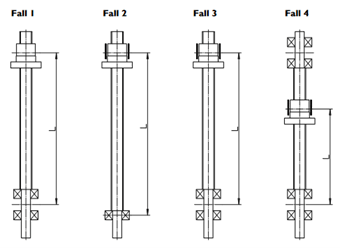
The straightness of threaded spindles depends on the manufacturing method, the material and the length of the threaded spindle. In the case of rolled screw drives, this is usually 0.3 / 300mm.
The straightness can easily be improved by straightening.
With aligned spindles, the packaging, shipping and handling of the components must be adapted to the higher requirements.
junaspin is happy to help you assess which straightness is actually necessary in the application and how this can be achieved in terms of production technology. We also ensure the appropriate packaging and shipping.
Sliding screw drives can be used in temperature ranges from -90 degrees to + 350 degrees. The selection of the right materials is of course crucial.
In addition to the temperature resistance of the material, the lubricant must also be suitable for the temperatures that occur.
For the function it is just as important to consider the temperature expansion coefficient as well as the temperature resistance. If, for example, the spindle and nut have completely different values, the nut may jam in the application. This can often be observed when combining a plastic nut with a steel spindle. The manufacture of a threaded nut with increased axial play could help here.
In addition to the ambient temperatures, the heat generated by friction must also be taken into account.
For applications in extreme temperatures, the strength values of the materials must also be taken into account. With plastics in particular, the permissible load on a threaded nut drops significantly with increasing temperature.
At temperatures well below zero degrees, in addition to the points mentioned above, an increased breakaway torque due to “freezing” of the nut on the spindle must be taken into account. Suitable lubrication is absolutely recommended here.
junaspin is happy to support you in the selection and design of your screw drive. We are happy to recommend appropriate materials for the temperature ranges occurring in your application. In addition to the calculation, we can also incorporate experience from “real applications” and tests.
In order to be able to integrate threaded spindles in the application, a tenon machining is usually required. Alternatively, spindles can also be used Clamp rings for small loads, storage can be carried out using Plain bearings can also be done directly on the thread.
In order to be able to cleanly connect bearings, drive wheels, clamping sets, couplings, etc. to the spindle, there are the following machining options:
- Cylindrical fits
- Surfaces (clamping surface, flat, D-cut, square, hexagon)
- Chamfers
- Recesses and grooves for retaining rings
- Axial and radial bores
- cone
- Axial and radial threads inside
- External axial thread
- Keyways
- Gears
- Pressing on, shrinking on and gluing on bushings and sleeves
All common machining methods are available for the production of these tenons, such as turning, milling, grinding, drilling, cutting, sawing, separating, pressing, eroding, honing, polishing, countersinking and slotting.
junaspin produces spindles ready for installation, according to customer drawings or to match the spindle bearings offered. If you are not sure which processing is useful or necessary for your application, please contact us.
The mobility of threads is usually determined by means of Ring gauges or plug gauges checked. By arrangement, a nut or a spindle can also be used as a counterpart for teaching. Gauges can be made for threads that do not conform to DIN or that require increased or reduced play.
In the case of plastic nuts, gauge accuracy can only be checked directly after production. Hygroscopic and thermal influences can subsequently lead to dimensional changes in the manufactured components.
The basis for testing the threads produced are the respective DIN standards, for example DIN103 for trapezoidal threads or DIN405 for round threads.
In addition to the threads, all other tolerances as well as shape and position tolerances are of course checked. Material tests can also be carried out.
The materials used are also checked
junaspin supplies screw drives with corresponding works certificates, works certificates and acceptance test certificates on request. According to EN10204, certificates 2.1, 2.2, 3.1 and 3.2 are required in particular. The initial sample presentation can take place with EMPB as well as with PPAP according to VDA. A 100% check is also conceivable.
In thread production, it is important to cope with a wide variety of requirements. The requirements of the market vary from project to project.
Various issues must be taken into account when preparing the offer:
- Which manufacturing method is suitable for the component?
- Can the material suggested by the customer even be used for the ideal production method? Can it be machined, cold formed, injected?
- What rework has to be done externally?
junaspin would like to devote itself to all projects, regardless of whether they are individual production or automobile series production. This also means that we are always looking for new projects in the field of miniaturization. We currently deliver threaded rods with a diameter of 1.5mm. But we are of the opinion that we can still develop in this area. Do you have inquiries for small parts?
In the area of large components, too, there are always exciting projects in clamping technology for bridges, power plants and in weirs, locks and gates. We have already implemented projects for components with a diameter of 385mm and a length of 16 meters (composed of several parts). But here, too, there is still room for improvement.
We would be very happy to see more exciting tasks and projects.
Of course, screw drives are subject to wear when they are dynamically stressed.
In order to minimize wear in an application, many basic considerations are first necessary:
- How much wear and tear occurs?
- How much wear is actually permissible in the application?
- In which component (spindle or nut) will wear arise or become problematic?
Once these questions have been clarified, optimizations can be aimed for:
- Increase in the area bearing share (e.g. longer nut)
- Protection of the thread against external influences (e.g. wipers or bellows)
- Improvement of the lubrication (e.g. different lubricant or different maintenance intervals)
- Optimization of the sliding partners (e.g. change of materials)
- Change of thread geometry (e.g. trapezoidal thread instead of metric thread)
- Improvement of the surface (e.g. sliding coating or heat treatment of the spindle)
Junaspin is happy to help with the design. Thousands of test results are documented in our database. In addition to the pure calculation, experience from “real applications” and tests can also be incorporated.
Every now and then screw drives are used in mobile devices, e.g. in wheel alignment devices, automobiles, stair climbers or medical devices. Weight plays a major role in these applications.
The reduction in weight can be significantly influenced by the choice of materials, for example by using plastic nuts in combination with aluminum spindles.
In some cases, the use of a safety nut / catch nut can also optimize the diameter of the screw drive because the safety factor can be reduced.
There is also the option of subsequently drilling the spindle hollow or rolling the thread onto a pipe.
junaspin will be happy to support you in the selection and design of your screw drive. We are happy to calculate the remaining strength after the weight has been “optimized”. In addition to the technical requirements, economic aspects are of course also relevant here. We can incorporate relevant experience from “real applications” here.
